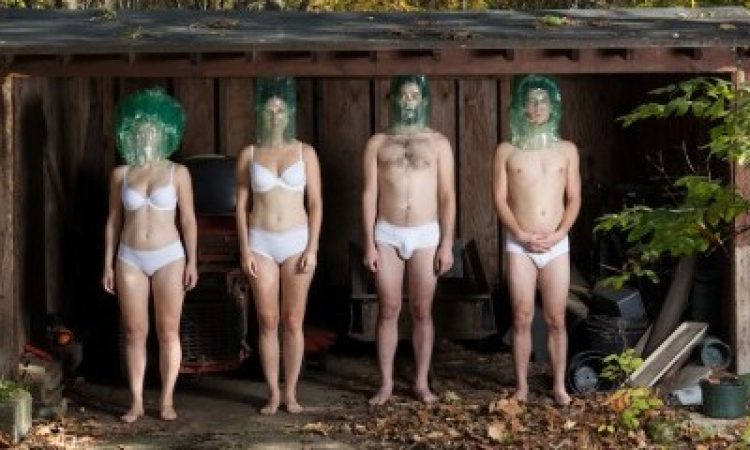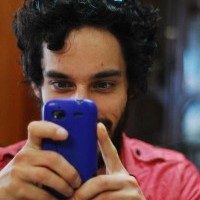Mano is a sport invented by the Philadelphia-based theater company New Paradise Laboratories. It works like this: two or more people stand in a ring nine feet in diameter, each balancing a quarter on the back of each of their hands. The goal is to knock the quarters off of the other players’ hands while keeping your own, or push other players out of the ring. Usually you end up standing with your body twisted, arms pointing out and neck craned in, and use your feet, shoulders, elbows, whatever else for offense.
Whit MacLaughlin, artistic director of New Paradise Laboratories, compares it to sumo wrestling. Sumo, says MacLaughlin, is “a game of delay. The whole thing is how long it takes to actually get to the big event. Then, the match is over in like one point five seconds. It’s really fast.
“All this contingency,” he goes on, “comes together in this little explosive moment of athletic action.” Mano isn’t quite so quick, but it does have long periods of mutual sizing-up followed by short bouts of armless wrestling and, soon after, the tinkling of quarters hitting the ground.
New Paradise makes devised performance. Their highly physical theater doesn’t originate in a script. Rather, through a research process including conversation, proposals, improvisations, and games, the company constructs a piece together, under the direction of MacLaughlin, who founded the company twenty years ago.
Mano is one thing that has come out of their recent research into contingency and probability. O Monsters First Draft, opening next week at Fringe, is another.
O Monsters First Draft is about mixed-gender identical triplets (a scientific impossibility) and their mother. The triplets believe in their guts that today will be an important day, but there is some unknown thing they have to do first. The triplets spend the play trying to make their day important. Meanwhile their mother observes them, trying to figure out what her children have become.
“Someone can become monstrous to you sort of out of the blue,” says company member Emilie Krause, on the concept of “monsters.” “Someone that you love completely can on a dime turn into something else. If you think about children growing up your relationship with a child shifts completely when they enter into adolescence.”
“The beings in O Monsters,” says MacLaughlin, “may or may not be human. They function according to rules and laws that I’m not sure we fully grasp.
“Through the creation of a nonhuman narrative,” he continues, “we’re creating the feeling of heightened contingency.”
A contingency is an event which you cannot be sure will happen. MacLaughlin started the research process with a deep interest in the concept of contingency, both from an artistic perspective—the ability to manifest the unexpected is key in theater—and from a humanistic one. Experts like Elie Ayache, who writes about contingency and the derivatives market in France, helped to sophisticate their understanding.
“A major principal behind Ayache,” says company member Kevin Meehan, “is that possibility exceeds probability. You want to think: there are all of these possibilities, and then the reality happens. The Wall Street crash in 2008, there were all these things leading up to it, but it was totally unimaginable until it happened—and then possibility existed.
“On the large scale,” Meehan continues, “that’s where horror comes in. That’s the unseen, the unknowable…You can’t imagine the thing that you can’t imagine.”
“When you come to a New Paradise piece,” says MacLaughlin, “you’re gonna see a system in action. We don’t tell stories of social change. I wouldn’t say they’re about individual people or individual psychology. They’re more about systems, with a lot of quandary, and a lot of mind blow and a lot of what the fuck. People who like our pieces like that kind of thing.”
I’m standing swiveled like a suspicious fish. I feel like a squirrel holding a precious nut behind it. As part of their research, New Paradise Labs has invited the public, and me, to a series of open Mano sessions as they develop O Monsters First Draft.
The game is smartly designed: by keeping the playing field very small, most of the natural advantages which might come with size or strength are eliminated. Agility and smallness can win out too, which the tenacious Krause proves again and again.
When I kick at Meehan’s hands, I can’t predict what will happen. My foot will make contact, possibly, knocking a coin to the ground, or he’ll move them out of the way. What actually happens is that Sebastienne, a really, really tall dude who is also attending this workshop, grabs my other leg in his free hand and lifts me off the ground. This is an unprecedented event. He places me outside of the ring. I lose Mano.
New Paradise Laboratories, O Monsters First Draft. FringeArts. April 23 – 30. FringeArts.com






